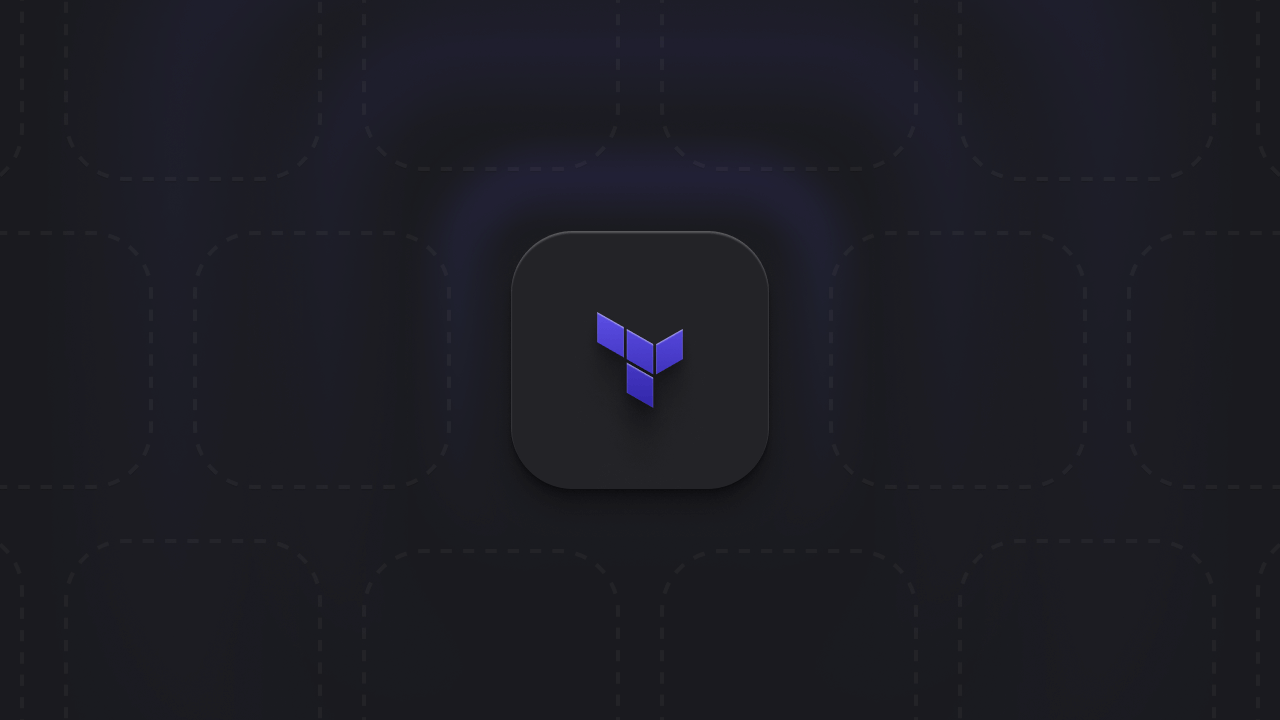The market for AI-powered Terraform tools has exploded in the past couple of years, evolving way beyond simple code completion into some genuinely sophisticated and specialized solutions.
The good news? There are now tools for pretty much every use case and team size. The challenge? Figuring out which one actually fits your needs.
Rather than ranking these tools from "worst" to "best," we've organized them into categories based on what problems they're trying to solve. Each category serves different needs – from developers who just want faster code completion to platform teams managing complex, multi-cloud infrastructure. Think of it less like a hierarchy and more like different tools for different jobs.
Here's how the landscape breaks down:
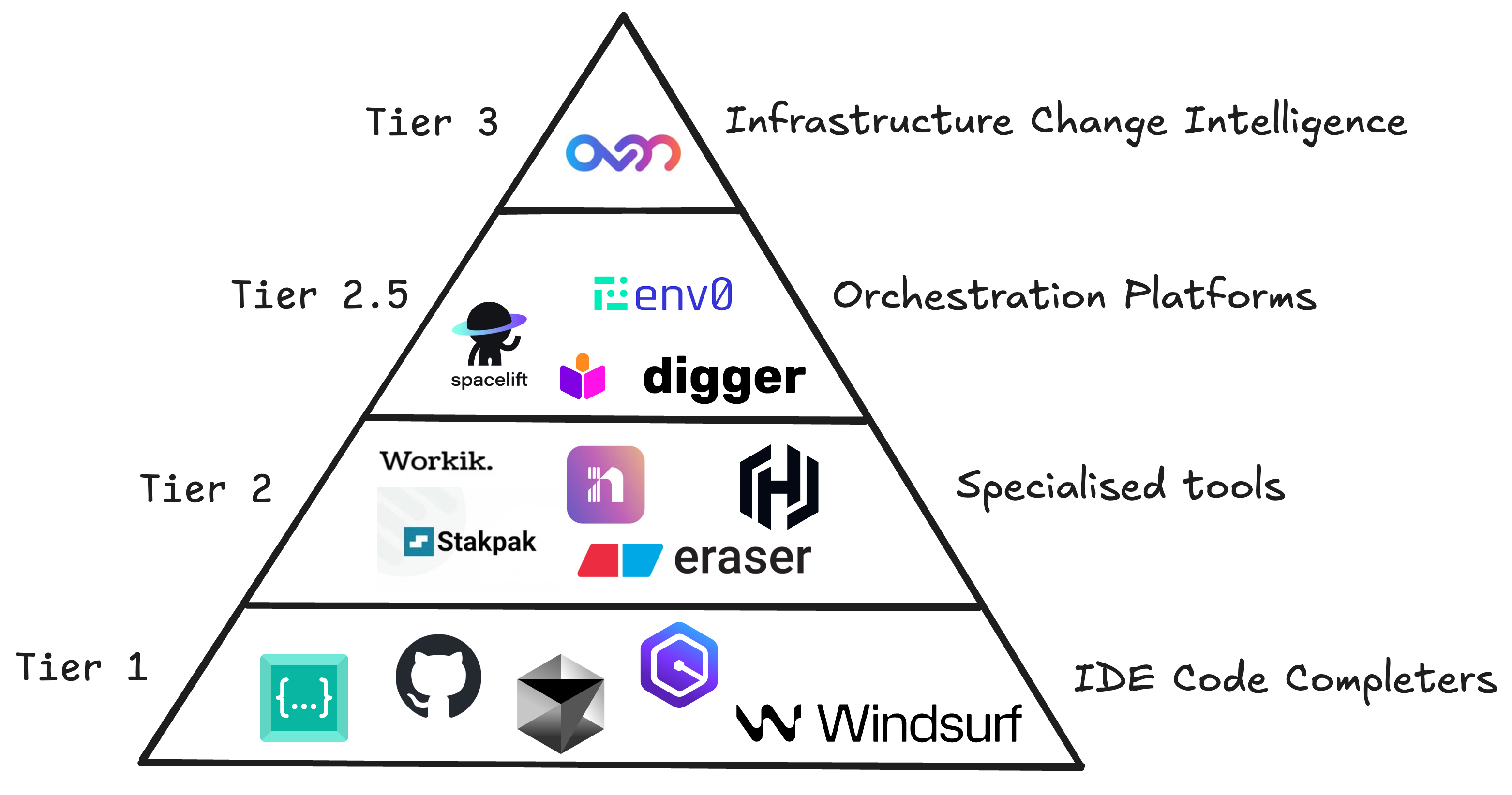
Tier 1: IDE Code Completers
These tools represent the most common and widely adopted form of AI assistance. Integrated directly into a developer's Integrated Development Environment (IDE), they function as AI pair programmers or, as some users describe them, "a better autocomplete." Their primary function is to suggest lines or entire blocks of code in real-time as a developer types.
GitHub Copilot: The most popular choice for good reason – it works in VS Code, JetBrains IDEs, Neovim, and pretty much anywhere you code. For Terraform specifically, it's great at suggesting resource blocks when you start typing, auto-completing provider configurations, and filling in common patterns like IAM policies or security groups. The chat feature is handy for asking "how do I create an S3 bucket with versioning?" and getting a quick HCL snippet.
But here's the thing – it's trained on public code, so it doesn't know about your specific AWS account setup or naming conventions. You'll catch yourself fixing obvious stuff like hardcoded region names or overly permissive policies. It's genuinely useful for learning Terraform syntax and speeding up the boring parts, but don't expect it to understand your infrastructure architecture. Think of it as a really smart autocomplete that occasionally needs adult supervision.
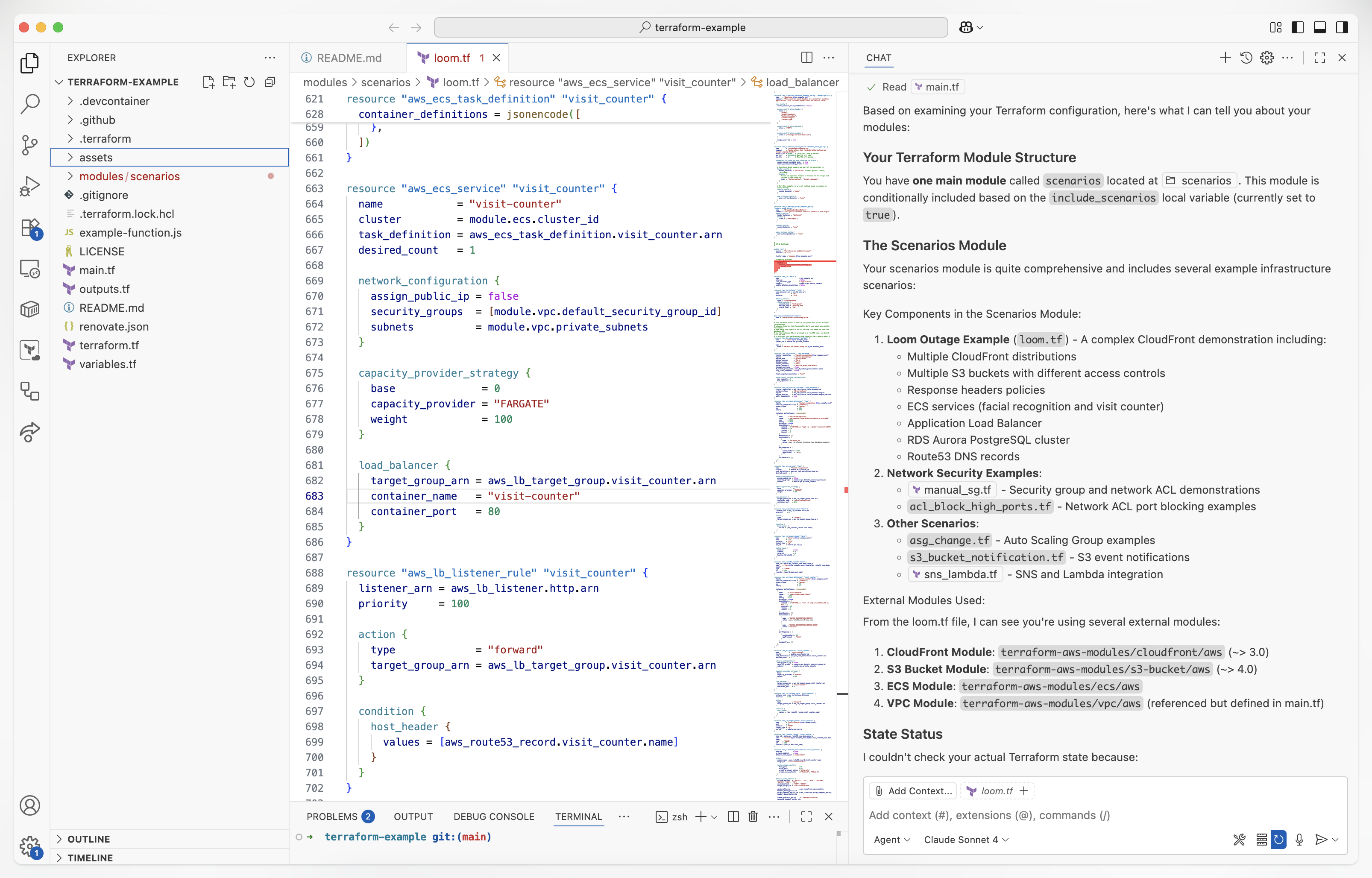
Cursor: This is basically VS Code but rebuilt from the ground up for AI. If you're already comfortable with VS Code, the transition is pretty smooth since it uses the same extensions and keybindings. The killer feature for Terraform is the agent mode – you can literally tell it "create a VPC with public and private subnets" and watch it generate multiple files, configure route tables, and set up NAT gateways.
It's wild when it works. The downside? It can get overly ambitious and create way more infrastructure than you asked for, or make assumptions about your AWS setup that aren't quite right. You'll spend time reviewing what it built and understanding why it made certain choices. It's definitely more powerful than basic code completion, but you need to be comfortable with AI that takes initiative rather than just filling in blanks.
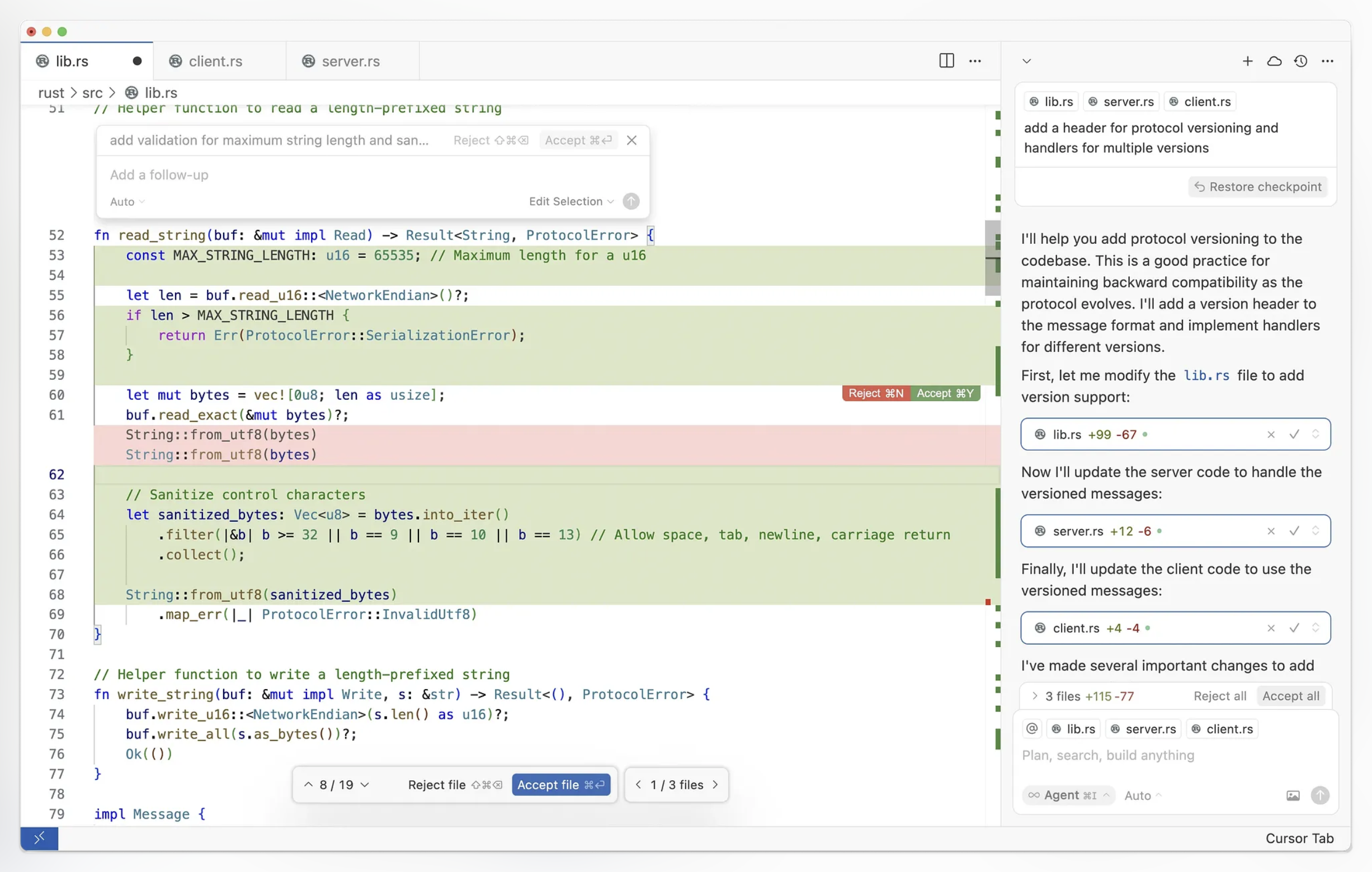
Amazon Q Developer (formerly CodeWhisperer): If you're heavily invested in AWS, this is probably your best bet for Terraform work. It's free with decent limits and integrates into VS Code, JetBrains IDEs, and AWS's own Cloud9. The big advantage is it actually understands AWS services and their relationships – it won't suggest deprecated instance types or incompatible configurations.
When you're writing Terraform for AWS resources, it suggests realistic configurations that follow AWS best practices. The security scanning is genuinely helpful too – it'll flag things like public S3 buckets or overly broad IAM permissions right in your editor. The catch is it's pretty useless for anything non-AWS. If you're doing multi-cloud or working with other providers like Kubernetes or Datadog, you're back to generic suggestions that may or may not make sense.

Tier 2: Specialised Tools
This is where things start getting more interesting. These tools aren't trying to be your everything assistant – instead, they tackle specific problems that actually matter when you're dealing with infrastructure. Rather than just helping you type faster, they're built to solve real pain points at different stages of your IaC journey.
Code Generators (e.g., Workik, terraform-ai): These are purpose-built web tools that convert natural language into Terraform code. Workik lets you connect GitHub repos, set cloud provider context, and generates configurations from prompts. The appeal is obvious – describe what you need instead of remembering syntax.
But the reality? The code often needs serious cleanup before production use, with tools missing critical elements like CloudWatch log groups or generating overly permissive IAM policies. They're helpful for learning or getting started, but treat them as first drafts, not production-ready code.
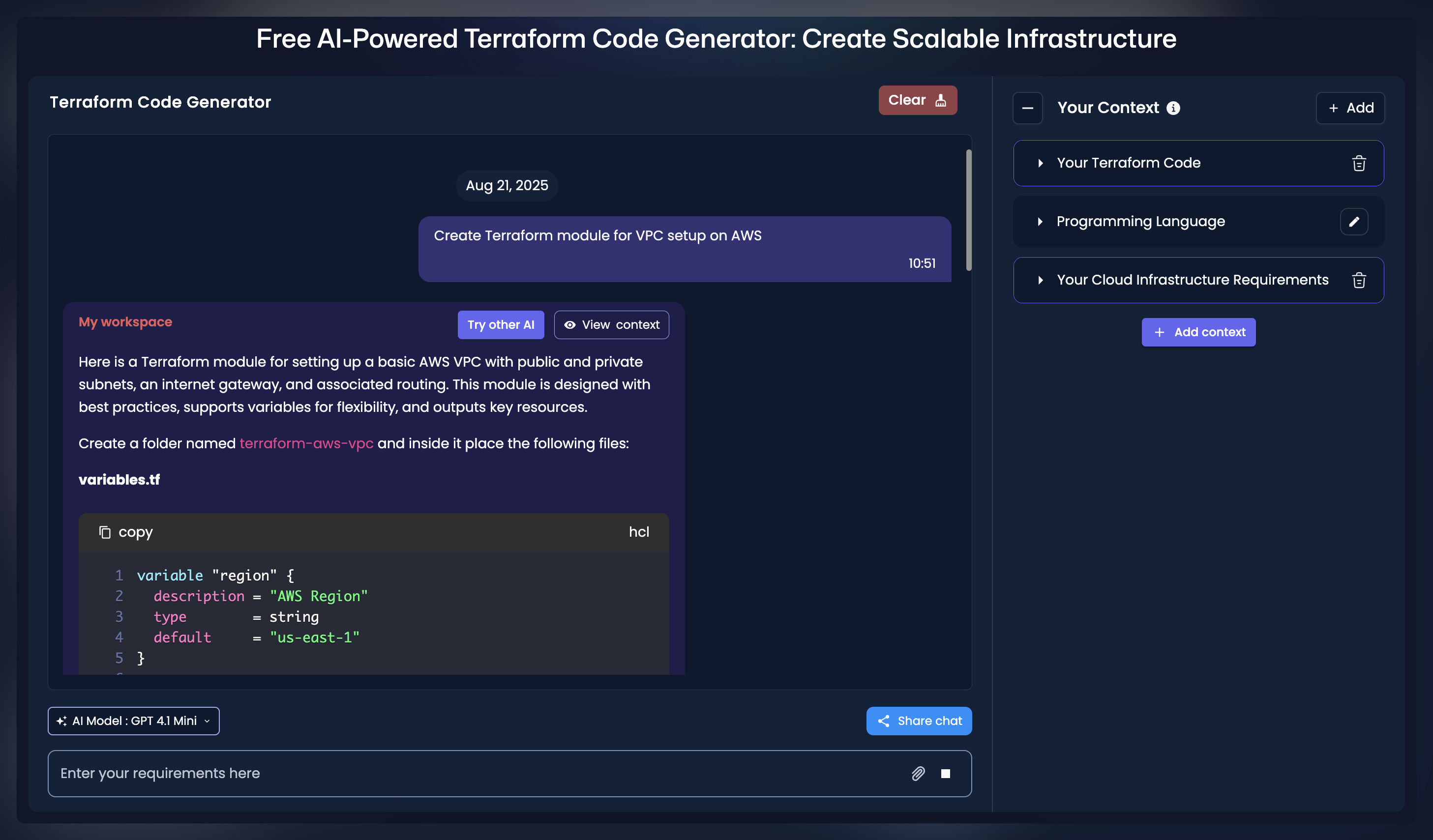
DevOps IDEs (e.g., Stakpak): Stakpak's core offering is DevX helps you define your own infrastructure abstractions so you don't have to write Kubernetes manifests, deal with Helm values, Terraform code, and Docker Compose manifests.
The platform uses CUE (a strongly typed configuration language from Google) to write configurations that can be transformed into various outputs like Terraform, Kubernetes, Docker Compose, and GitHub Actions.
DevX allows platform teams to create reusable components, traits, and transformers that encode best practices and security guardrails. Developers can then use simple, high-level abstractions to define their workloads, and DevX automatically generates all the underlying infrastructure code they need across different environments. The goal is to let developers define their intent once and have it work across any environment (local, dev, staging, production) and any vendor's offerings.
The new AI innovation is the Stakpak Agent – an open-source DevOps agent built in Rust that represents a completely different approach to AI assistance. The agent is designed for operations and DevOps workflows, running in your terminal, CI/CD pipelines, and cloud environments.
It can quickly identify root causes from your terminal and implement fixes to resolve production incidents faster, analyze existing policies and write more secure policies on the fly, and automate containerizing applications with well-tested Dockerfiles. The Stakpak Agent analyzes your existing infrastructure, learns from your environment, and adapts to your internal practices to provide contextually relevant recommendations and smarter automation.
Earlier benchmarks showed it achieving 95% one-shot validity for Terraform configurations, with 1,900 out of 2,000 generations passing syntax and schema validation.
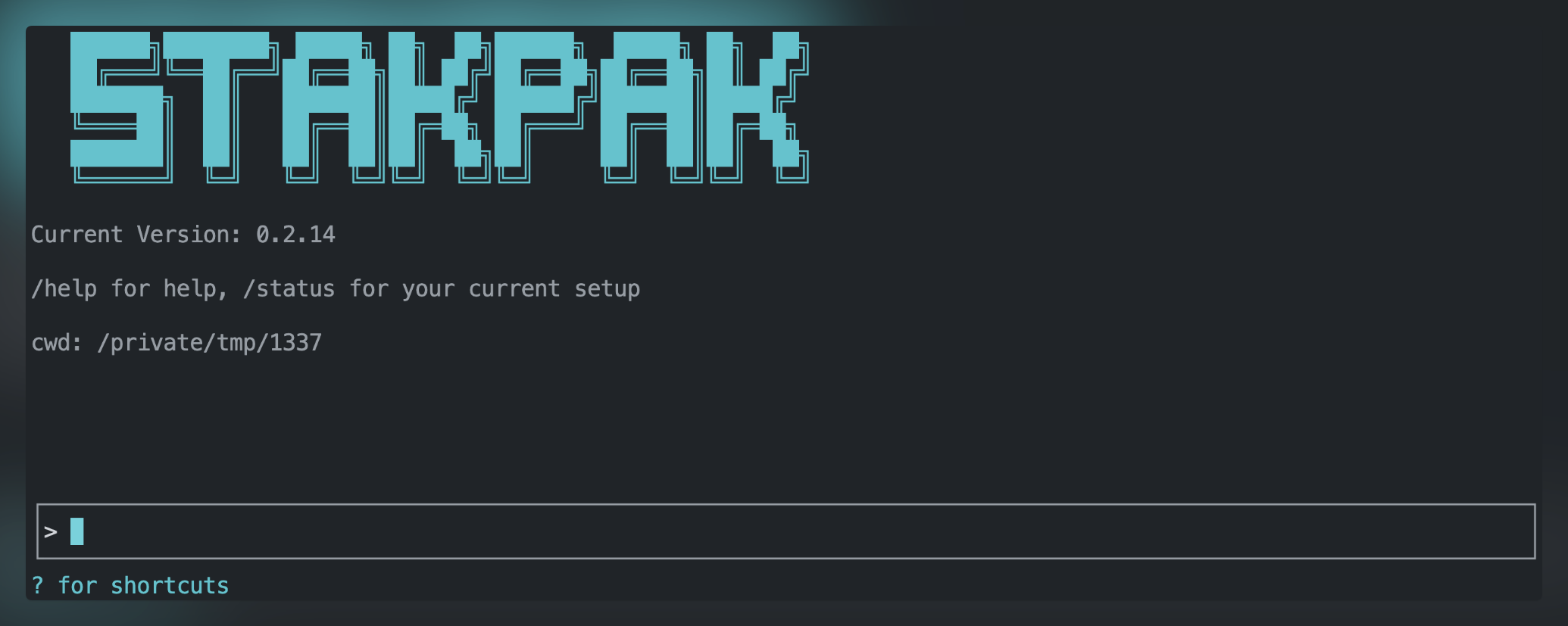
Auxiliary Tools (e.g., Eraser.io): These solve the "everything else" problems that come with managing infrastructure. Eraser.io automatically generates architecture diagrams from your Terraform code – which sounds simple but is actually incredibly useful when you're trying to explain your infrastructure to stakeholders or onboard new team members.
Other tools in this category include Infracost, which estimates what your Terraform changes will cost before you deploy them. These aren't going to write your infrastructure for you, but they solve real day-to-day pain points.
The fact that these specialised tools exist shows that the infrastructure game is about way more than just writing HCL files - you need visibility, cost control, documentation, and security scanning. Think of them as the supporting cast that makes your infrastructure actually manageable in the long run.
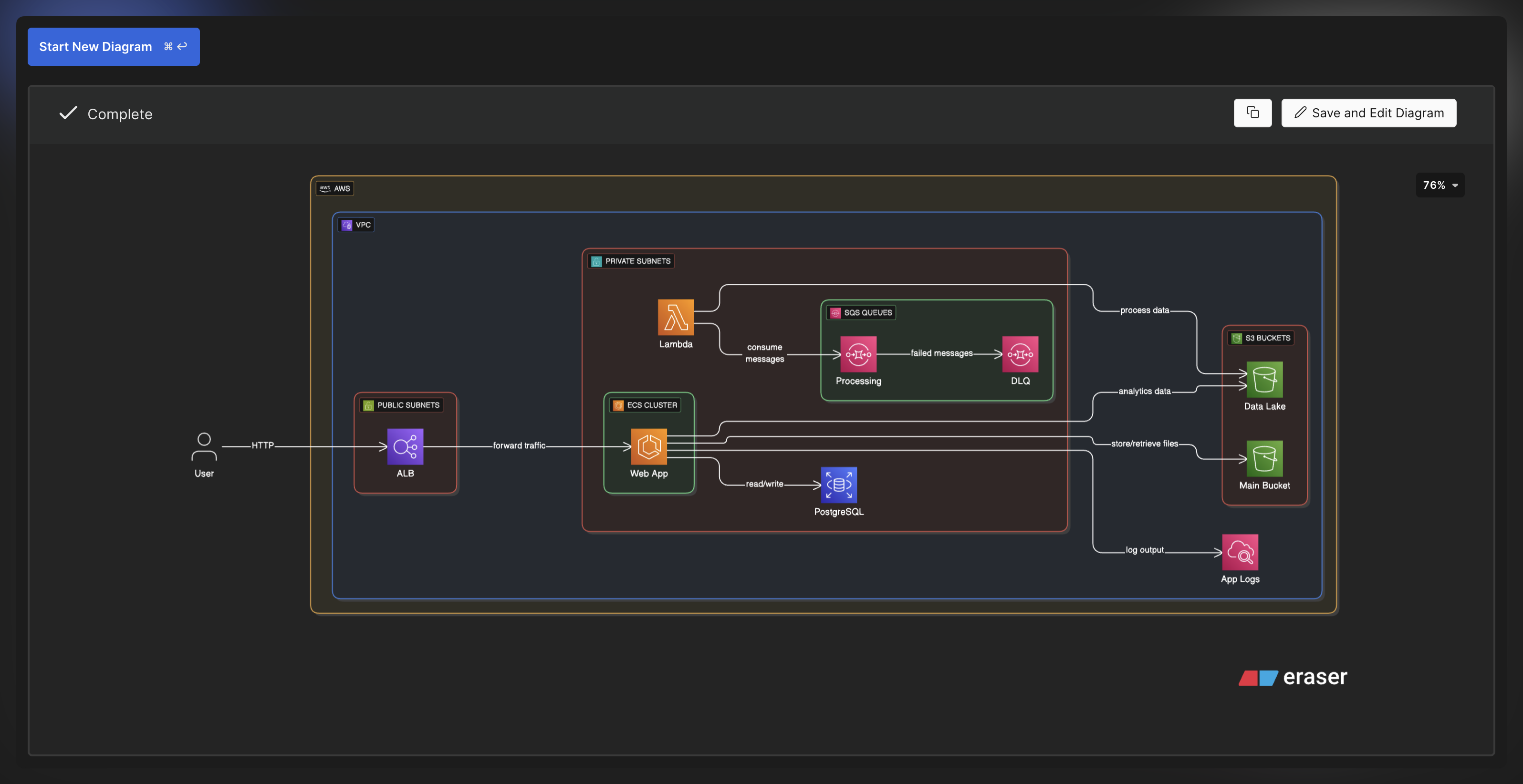
HashiCorp Terraform MCP Server: This is HashiCorp's official bridge between AI assistants and the Terraform ecosystem. The MCP server enhances AI models with real-time access to current Terraform provider documentation, modules, and policies from the Registry, ensuring AI-generated configurations use accurate, up-to-date information rather than potentially outdated training data.
Rather than being another standalone tool, it works with existing AI assistants like Claude Desktop, VS Code with GitHub Copilot, and Amazon Q Developer through the standardized Model Context Protocol. The server includes Terraform style guides and module development guides, enabling AI models to generate code that adheres to official HashiCorp standards.
The key advantage is that AI assistants can now access the most current Terraform documentation and best practices directly from the source, rather than relying on potentially outdated training data.
This represents HashiCorp's official approach to AI integration - enhancing existing workflows with better, more current context rather than replacing them.
Tier 2.5: AI-Powered Orchestration Platforms
This is where things start getting really practical. These platforms weren't built as AI-first tools trying to solve everything with a chatbot. Instead, they're mature infrastructure orchestration platforms that have strategically integrated AI to solve the actual day-to-day problems DevOps teams face.
They understand that writing Terraform code is only about 20% of the job - the other 80% is deploying it reliably, troubleshooting when it breaks, keeping track of what's actually running in your cloud accounts, and maintaining security and compliance at scale.
What makes this category unique is that these tools focus on operational intelligence rather than code generation. They're answering questions like "Why did my deployment fail?", "What resources are drifting from my defined state?", and "Which of my cloud resources aren't managed by code?" These are the questions that keep infrastructure engineers up at night, and traditional code completion tools are completely useless for solving them.
env0: env0's core platform is a comprehensive Infrastructure as Code automation and orchestration solution.
The platform supports Terraform, OpenTofu, Pulumi, CloudFormation, and Kubernetes, providing automated remote-run workflow management for cloud deployments. At its foundation, env0 offers developer self-service capabilities, GitOps workflows, cost monitoring, drift detection, policy-as-code guardrails, and collaborative PR automation. The platform automatically tags resources and environments, providing detailed cost visibility and audit trails without requiring manual tagging.
The AI innovation comes through their Cloud Intelligence Suite, which includes several new AI-powered features. Their Cloud Compass feature uses proprietary AI-assisted logic to analyze your infrastructure posture and can detect drift within minutes, even before you've fully onboarded to env0.
Cloud Compass scans your cloud accounts and identifies resources that aren't managed by IaC (the dreaded "ClickOps" resources), assigns them risk-based severity scores, and can even generate Terraform import blocks using GenAI to bring them under management.
The newer Cloud Analyst is an AI-powered tool that gives teams instant access to infrastructure insights through natural language queries. You can literally ask questions like "Which resources are costing us the most?" or "Show me all unmanaged resources in production" and get immediate answers.
Additionally, their Drift Cause Analysis feature uses AI to explain why drift happened, providing context needed for quick, informed reconciliation. The combination of mature IaC orchestration with these AI-powered intelligence features makes env0 a comprehensive solution for both Day 1 and Day 2 operations.
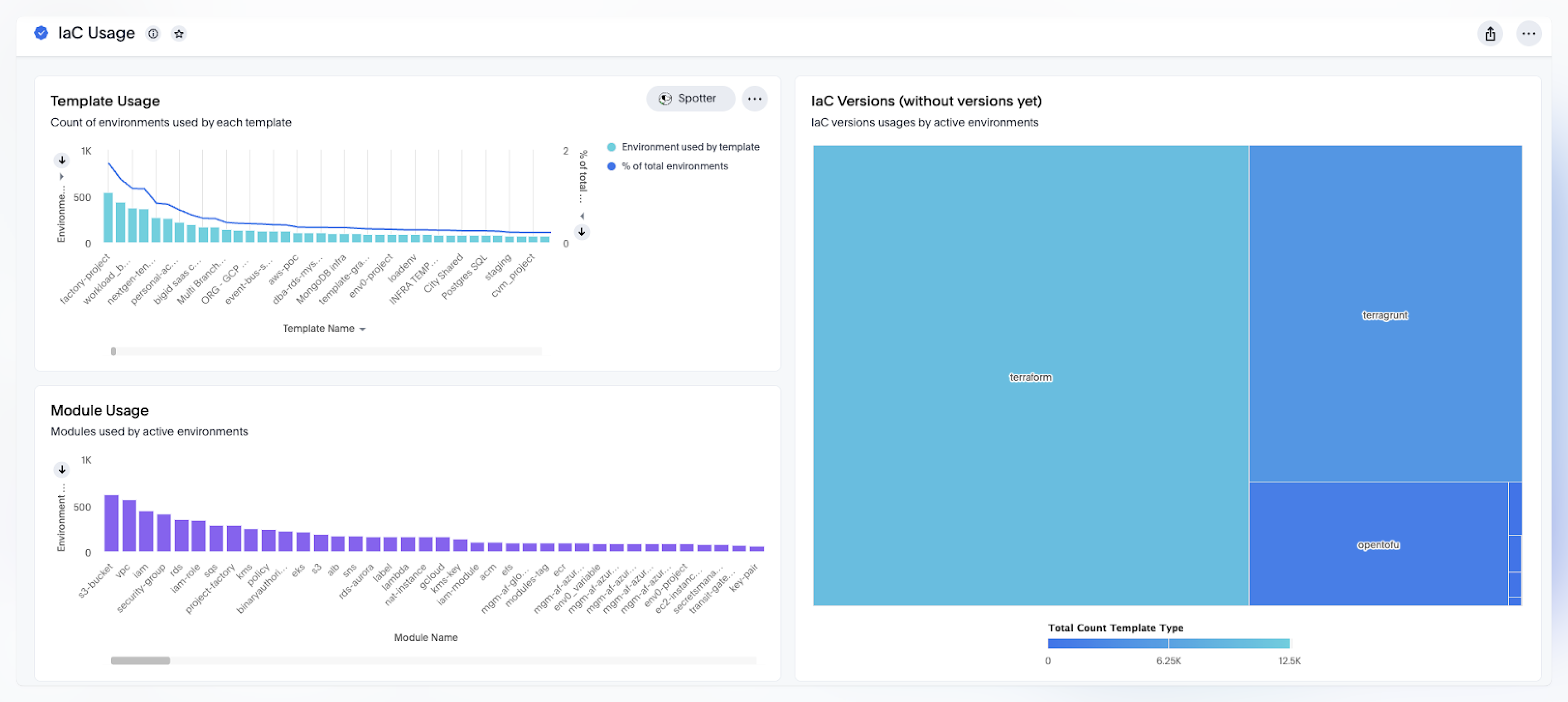
Spacelift: Spacelift's core offering is a robust infrastructure orchestration platform that's been designed from the ground up for managing complex IaC workflows at scale. The platform supports Terraform, OpenTofu, Terragrunt, Pulumi, CloudFormation, Ansible, and Kubernetes, providing a single integrated workflow for provisioning, configuration, and governance.
Unlike generic CI/CD tools, Spacelift is purpose-built for infrastructure teams, offering advanced features like stack dependencies, policy-as-code with unlimited OPA policies, GitOps flows, and comprehensive RBAC. The platform provides developer self-service capabilities through Blueprints, resource visualization, and integration with observability tools like Datadog and Prometheus.
The AI advancement is Saturnhead AI, which launched in April 2025 as an enterprise-grade addition to the platform. According to Spacelift's own research, 43% of DevOps teams must deploy infrastructure four times or more before getting it right - an inefficiency that drains hours of engineering time on each failure.
Saturnhead analyzes infrastructure run logs in real time and provides clear, natural-language explanations of what happened, why it occurred, and what steps should be taken to resolve issues. You can choose which LLM model powers the analysis, and admins can enable features for users with read access to runs.
For enterprise environments, even with a modest 5% run failure rate, Saturnhead AI can eliminate the need to troubleshoot over 1,000 failed runs per week. The tool also generates summaries for successful runs, not just failures, making it incredibly useful for understanding what changed during deployments.
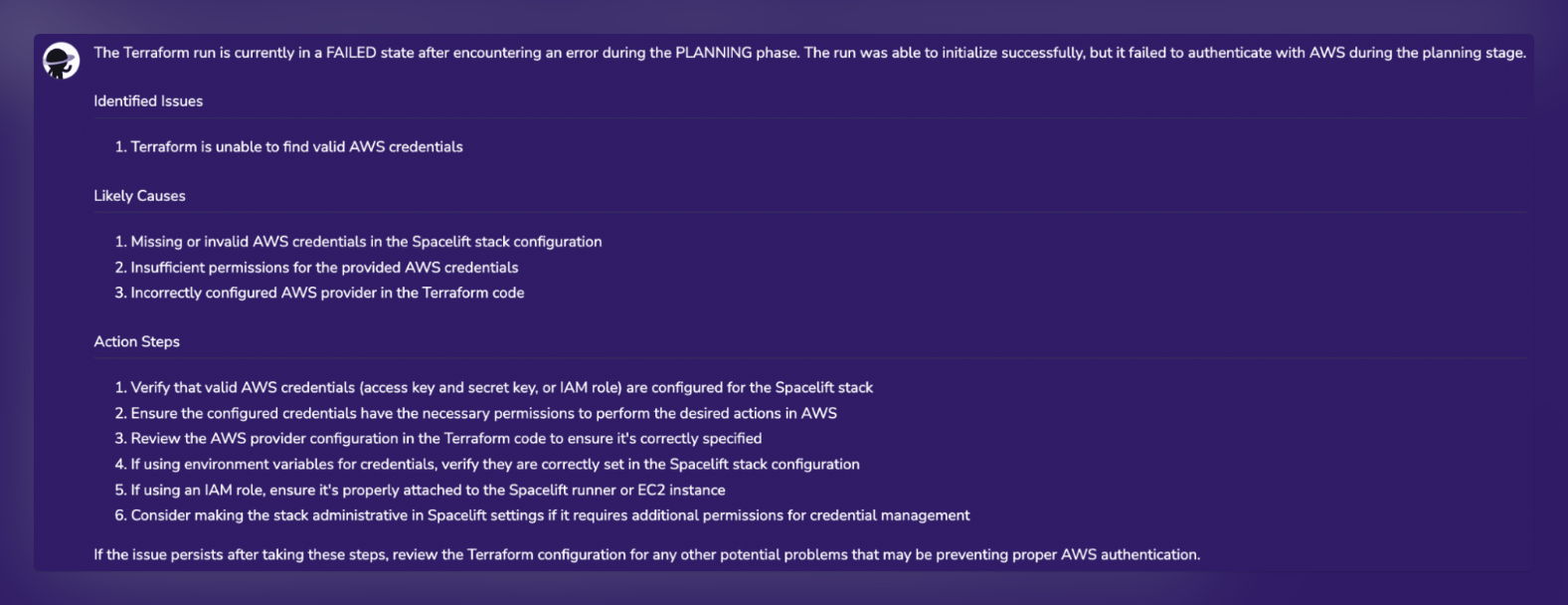
Digger: Digger takes a fundamentally different approach with their core CI/CD orchestration platform. Instead of being another third-party platform you have to maintain, Digger runs directly in your existing CI/CD pipeline (GitHub Actions, GitLab CI, etc.), so your cloud credentials never leave your environment.
This is huge for security-conscious organizations - there's no sharing of secrets with external services, and you're not paying for additional compute since it uses your existing CI infrastructure.
The core Digger platform automatically runs terraform plan when you open a pull request and posts the results as a comment. You can then comment "digger apply" to trigger the deployment, all while maintaining PR-level locks to avoid conflicts.
It supports advanced features like role-based access controls via Open Policy Agent (OPA), drift detection with Slack alerts, and works with Terragrunt, multiple Terraform versions, and static analysis tools like Checkov.
The new addition is Infrabase - an AI-powered DevOps agent that lives directly in your pull requests. Infrabase scans code and organizational context to surface security gaps, cost spikes, and policy breaks before they ever hit your cloud.
Instead of requiring complex OPA policies, you can write rules in natural language as simple Markdown. The tool provides instant blast-radius, cost and security scoring on every PR, and can block merges based on critical findings. Infrabase securely indexes and learns from your infrastructure code to build deep contextual understanding without storing raw code.
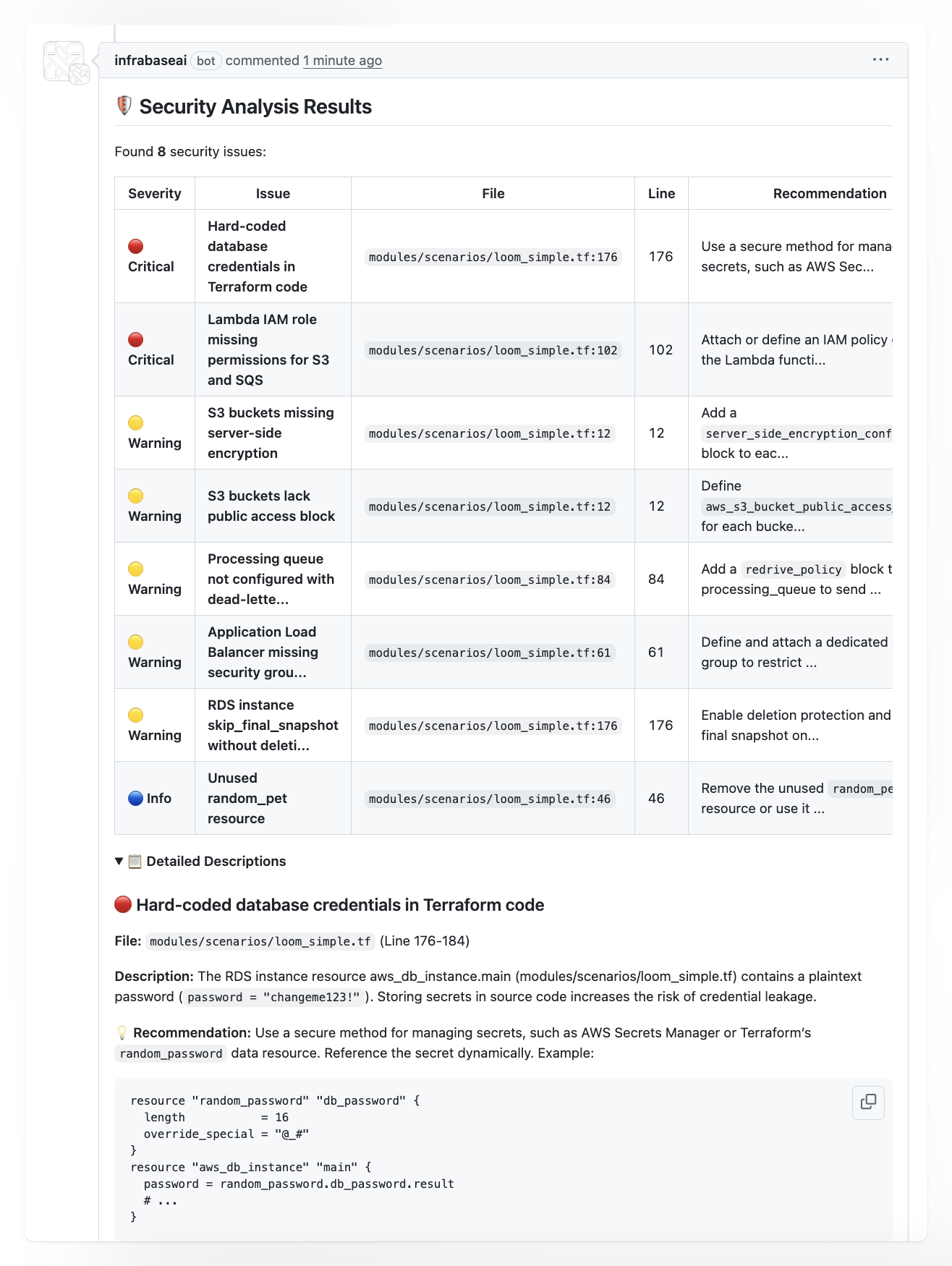
Tier 3: Infrastructure Change Intelligence
This represents the bleeding edge of where infrastructure management is heading. These platforms don't just help you write code or automate deployments - they fundamentally change how you think about and interact with complex, interconnected systems.
They're built around the premise that modern infrastructure is too complex for humans to hold in their heads, and that the real value lies in helping engineers reason about systems rather than just manipulating individual resources.
What sets these platforms apart is their focus on context and relationships. They understand that when you change a security group, the impact ripples through your entire system in ways that aren't obvious from looking at Terraform code. They're designed to surface those hidden dependencies and help you understand the real-world consequences of your changes before you make them.
Overmind: Overmind represents a fundamentally different approach to infrastructure intelligence. While `terraform plan` and other tools focus on what will change, Overmind shows you what will actually be impacted.
The platform works by building a real-time graph of your entire infrastructure - not just what's in your Terraform code, but everything that exists in your AWS account and Kubernetes clusters, regardless of how it was created.
When you run `overmind terraform plan`, it doesn't just show you the Terraform plan output - it maps out all the potential dependencies and interactions that could be affected by your change in real-time. This includes resources created through the console, CloudFormation, or any other method, across multiple accounts and regions.
What makes this particularly powerful is the risk assessment capability. By taking into account the complete blast radius, Overmind can intelligently predict specific risks before making a change - from pre-existing problems and mismatched configurations to simple human errors.
These risks are delivered directly to your pull requests, allowing teams to make deployment decisions within minutes rather than hours.

Overmind integrates into your existing CI/CD pipelines, automatically creating changes from pull requests and showing blast radius, risk analysis, and diff for each change without leaving your CI system. The platform works with read-only access, never requiring elevated permissions, and can be set up in about 3 minutes.
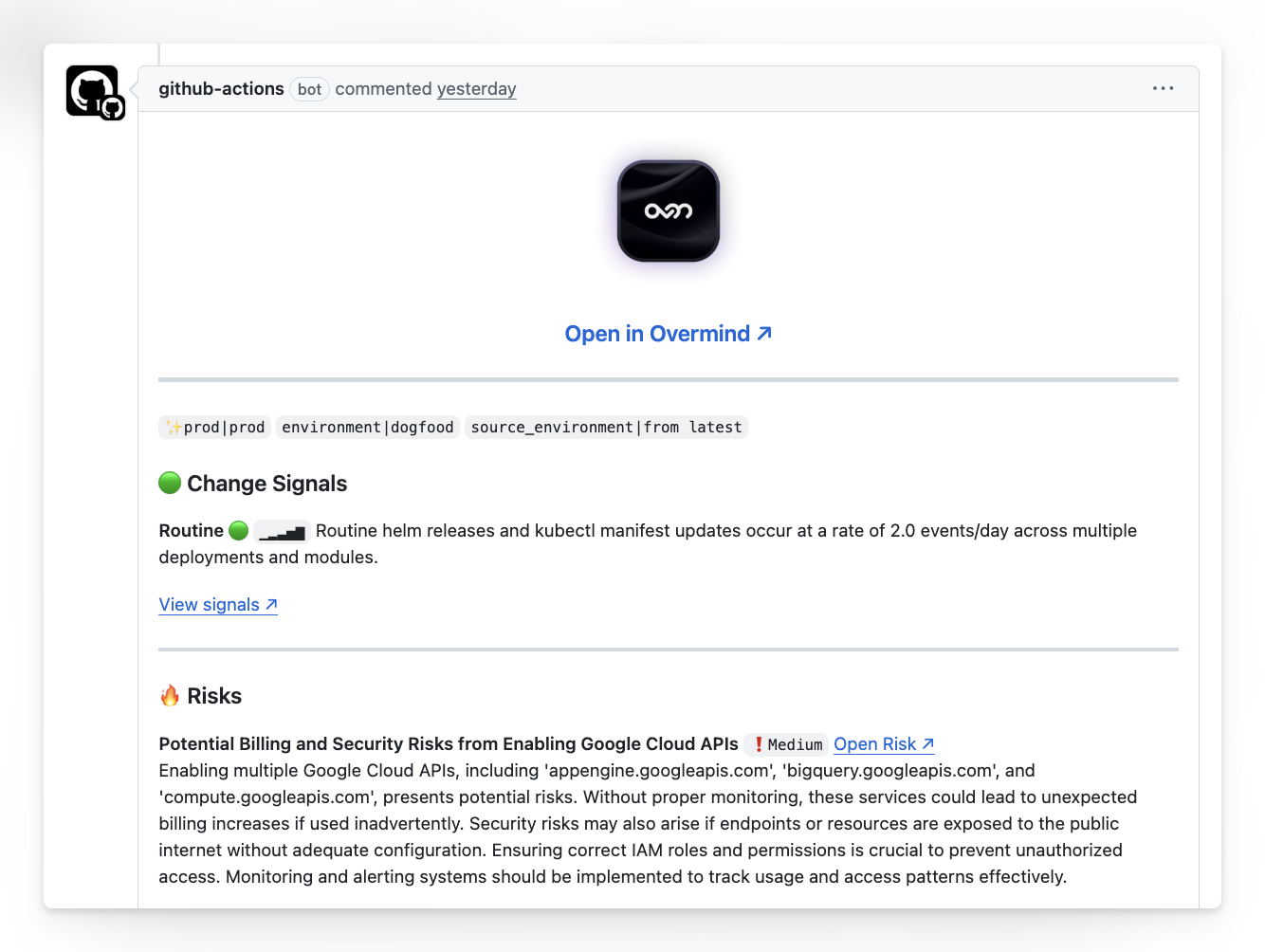
This represents the future of infrastructure management - moving beyond simple automation to true intelligence that helps engineers understand the complex systems they're managing. Rather than relying on "tribal knowledge" where expert staff are stuck doing approvals, Overmind democratises infrastructure understanding, enabling even newer team members to confidently deploy changes faster.
Choosing the Right Tool
Start here with 'what's your primary pain point?'
- "I just want to write Terraform faster" → GitHub Copilot, Tabnine, or Amazon Q Developer
- "I need help with deployments and troubleshooting" → Spacelift, env0, or Digger
- "I want to understand my infrastructure better" → Overmind
- "I'm new to Terraform" → Code generators like Workik, then graduate to IDE completers
Red flags to avoid:
- Tools that generate insecure code (wildcard IAM policies, public buckets)
- Solutions that can't see your existing infrastructure
- AI that only helps with Day 1 (writing code) but ignores Day 2 (operations)
Feature Comparison table
The following table provides a consolidated view of how these leading tools compare against the key evaluation criteria.
This comparative analysis makes it clear that while code completers offer baseline productivity gains and specialised IDEs represent a step forward, the orchestration platforms add crucial operational intelligence, and a true professional-grade solution must offer the deep contextual awareness and full-lifecycle support characteristic of an Infrastructure Intelligence Platform.
